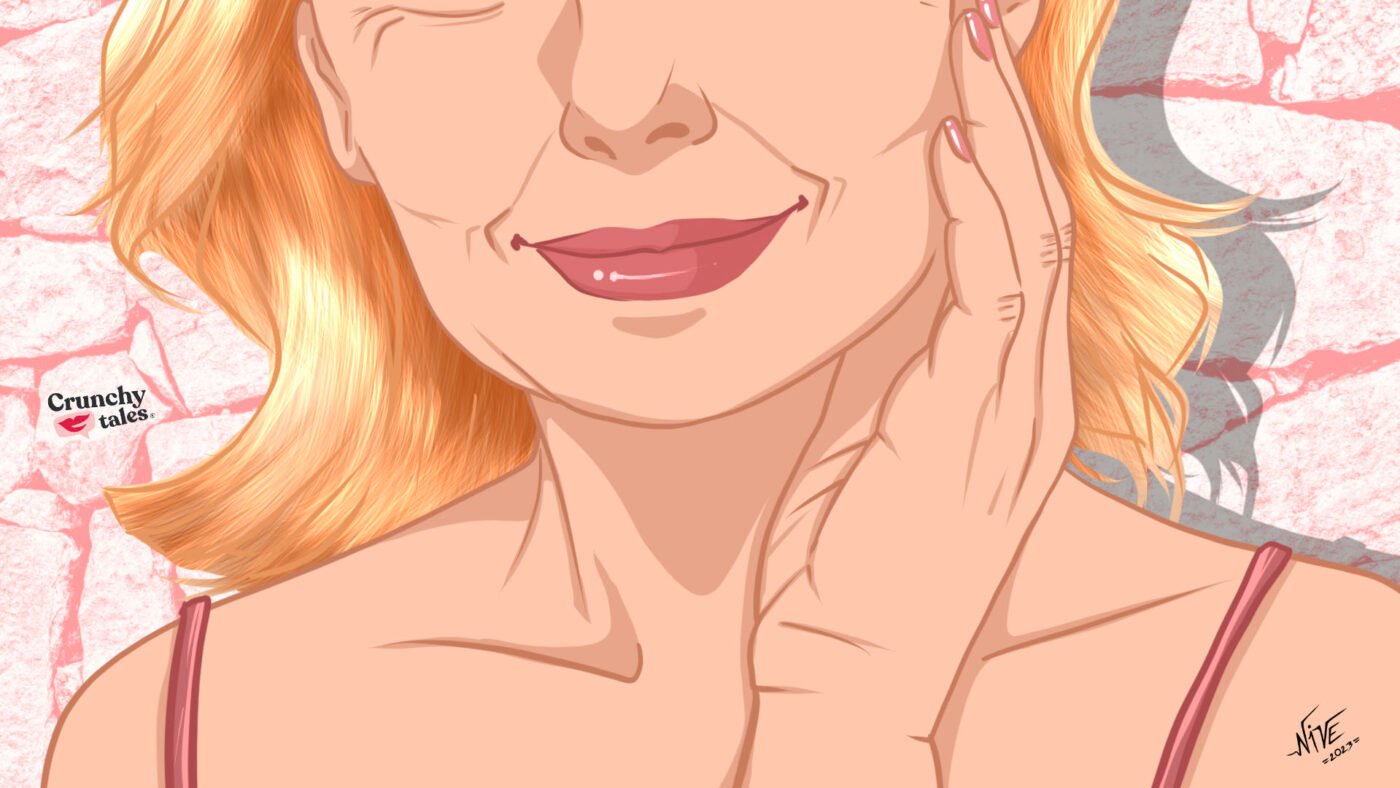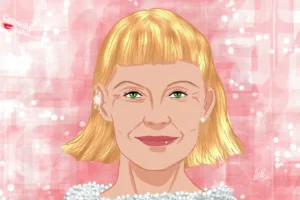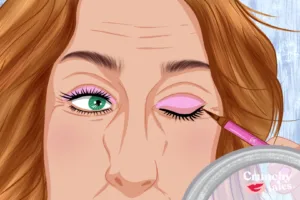Say Goodbye to Menopause Peach Fuzz: Why Depilatory Creams Are Still Our Favourites
Menopause isn’t just about hot flushes and night sweats; it also affects the growth of unwanted facial hair. Enter peach fuzz on our chin or upper lip.
These changes are typically caused by an increase in the ratio of androgen (testosterone) to estrogen and most of the time are completely normal, but still, they can be bothersome for many midlife women, leaving them feeling self-conscious and frustrated.
As each person’s journey through menopause is unique, so is the method to choose to manage unwanted facial hair. If you’re determined to eliminate peach fuzz, grow thicker whiskers, or darken hair growth on your face, continue reading for our expert advice.
And always keep in mind – handle with care! The skin on your face is incredibly delicate.
What is peach fuzz?
Typically, peach fuzz – also known as vellus hair- refers to the delicate baby hairs on your face, particularly on your upper lip, cheek, or chin. The amount of peach fuzz varies from person to person; hormonal imbalances typical of menopause and certain medical conditions can lead to increased growth or darkening of facial vellus hair.
Its removal can make a noticeable difference in achieving a smooth complexion and improving the application of cosmetics.
How menopause affects peach fuzz growth
According to the North American Menopause Society, while estrogen and progesterone decline, levels of a chief “male” hormone – testosterone – remain steady. Without estrogen and progesterone to take it down a notch, testosterone can trigger the production of facial hair.
In fact, a study revealed that nearly 40% of women aged 45 and above have an excess of facial hair growth, particularly on the chin. Another study suggests that it is highly likely for women to experience unwanted facial hair after menopause.
Ensuring you get all the necessary nutrients by taking a high-quality multivitamin, managing stress levels, and keeping your body fat below 30% are all important steps to balance your hormones (both stress and excess body fat can contribute to increased androgen production).
However, while a healthy lifestyle and hormone therapy can potentially help reduce unwanted facial hair during menopause, their effectiveness for this specific purpose may vary from person to person and sometimes they are not enough to prevent the growth of peach fuzz on your face.
Fortunately, there are various methods available to remove or minimize its appearance.
What can be done to address unwanted facial hair?
Hair removal on the face takes a different approach altogether than the rest of the body. Much like the intimate area – it’s a whole different ball game. Depending on the extent of growth, plucking, tweezing, threading, epilating, waxing or even shaving can help. If desired, you can even consult with your doctor who may prescribe a topical cream to slow down hair growth.
In some cases, when suffering from excessive hair growth on the face, professional laser removal or electrolysis may be recommended, too.
- Electrolysis
It involves using a targeted electric current to kill hair follicles, eliminating permanent hair hair. Although expensive, it offers long-lasting results – especially on dark hairs- preventing regrowth.
The process begins with a trained professional inserting a fine, sterile needle into each hair follicle individually. This needle is connected to a small device that emits a low-level electrical current. As the current is applied, it destroys the hair follicle, preventing future hair growth in that area. The duration of each session depends on the size of the treatment area and the density of the hair but typically ranges from 15 minutes to an hour.
While some individuals may experience mild discomfort during the procedure, it is generally well-tolerated, and the results are worth it.
- Laser hair removal
Laser hair removal is a highly effective and popular cosmetic procedure that utilizes advanced laser technology to permanently reduce or eliminate unwanted hair. This non-invasive treatment works by targeting the hair follicles with concentrated beams of light, which are absorbed by the pigment in the hair, ultimately destroying the follicle and preventing future hair growth, so long-term results are almost guaranteed, no matter your age.
The treatment is precise, allowing for selective hair removal without damaging the surrounding skin. It is important to note that multiple sessions are usually required to achieve optimal results, as hair grows in cycles and the laser can only effectively target hair in the active growth phase.
However, each session is relatively quick, depending on the size of the treatment area, and the discomfort experienced is minimal, often described as a mild stinging sensation or the feeling of a rubber band snapping against the skin.
What if I prefer other facial hair removal options?
With the abundance of treatments, creams, waxes, and tools available, it can be challenging to determine which one is best suited for your skin. That’s probably why Dermaplaning has quickly become one of the most sought-after treatments in the US and is gaining popularity in the UK too as a solution for menopausal facial hair removal.
Essentially, Dermaplaning involves the gentle shaving of the face using either a specially designed device for home use or a surgical-grade scalpel in the skilled hands of a qualified practitioner. Scraping the blade over the skin’s surface, not only effectively removes any unwanted peach fuzz, but it also provides a chemical-free exfoliation, resulting in a radiant complexion.
However, without knowing the correct technique, such as the right angle and how you should hold the blade, you can easily cut the skin and this can lead to infection. Better ask a professional.
Why depilatory creams are still the most effective method
If you are looking for a more cost-effective and time-saving alternative hair removal products are the solutions.
As a rule of thumb, using a razor on yourself is an absolute no-no. Many midlife women may believe it’s harmless to shave off a few stray facial hairs, but it’s a risky move that should be avoided at all costs. Unlike laser hair removal, which prevents hair from growing back darker and thicker, shaving has the opposite effect. Even those pesky grey hairs will come back coarser than before with the risk of ingrown hairs, razor burns, and even unsightly scars.
The same goes for tweezing – if you go overboard, you’re putting yourself at a higher risk of infection, scarring, and those dreaded red bumps.
Honestly, here at CrunchyTales, we’re still huge fans of the classic depilatory creams. Hair removal creams are undoubtedly the most effortless option for getting rid of unwanted hair.
While IPL laser machines offer a more permanent solution, epilators are technologically advanced, and razors may be at times convenient for on-the-go use, these creams have a unique advantage that sets them apart from their competitors – pure and unadulterated ease. And to top it off, they are also gentle on your wallet.
These products are far from those used by our grandmas: gone are the days of harsh chemicals and unpleasant odours in hair removal creams. Depilatory creams have undergone a major transformation since the 90s. The main ingredient in these creams is thioglycolic acid, which effectively breaks down keratin, a protein naturally found in hair, but in order to ensure the creams are gentle on the skin, they are often enriched with ingredients like aloe vera or vitamin E to moisturize and soothe.
However, it’s important to note that this is still a temporary solution, as new hair will start to grow back in just a few days. Additionally, if you have sensitive skin (as hormonal changes occur, it may become more prone to dryness, irritation, and redness), there is a possibility of irritation, so it’s always wise to perform a patch test and monitor your skin for 24 hours after use.
In conclusion, what we don’t want is to allow the natural occurrence of menopause and its symptoms to hinder our journey towards absolute greatness. Let’s embrace this phase of life with unwavering confidence and let our radiance shine through. Menopause may bring about some changes, including the appearance of peach fuzz, but these are mere details in the grand scheme of our new chapters.
Like this post? Support Us or Sign up to our newsletter to get more articles like this delivered straight to your inbox!





